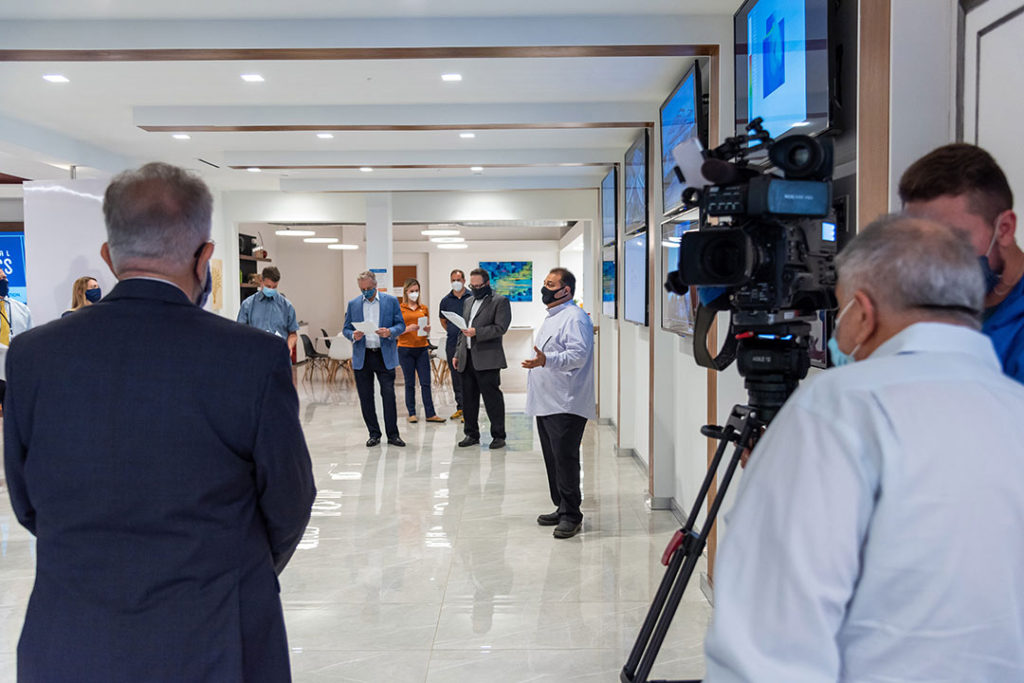Immediate solutions to safely get employees back in the office
Global health security is a state of freedom from the scourge of infectious disease, irrespective of origin or source. It is achieved through the policies, programmes, and activities taken to prevent, detect, respond to, and recover from biological threats. These threats know no borders and have global consequences requiring more effective collective action.
— Sydney Statement on Global Health Security, 2019
The Texas Global Health Security Innovation Consortium (TEXGHS) has taken off, launching a unique initiative to fight COVID-19 and be prepared for tomorrow’s challenges. Attracting proven professionals in technology, healthcare and health security, TEXGHS has built an ecosystem of volunteers compromising a dream team of funders and innovators. Consortium leaders in academia, as well as in the public and private sectors, have joined forces with entrepreneurs, venture capitalists, engineers, doctors and scientists to discover, create, test and finance solutions with the capabilities to free us all from the “scourge of infectious disease.”
Bringing together these heavy hitters and encouraging them to meld their vast global networks of expertise and experience to unearth sustainable responses to the multiple threats of COVID-19 was in itself an innovation: a serious straightforward plan for collaboration that’s already produced results. Short months after its March 2020 inception, a group of TEXGHS partners unveiled their virus combatting answer. It’s a fix that could reopen the economy.
In the ozone
Ozone is a natural antioxidant and an ideal disinfectant for air, surfaces, and water. Isolated atoms of ozone can kill bacteria and viruses like COVID-19 and current research confirms that no microorganism is immune to its disinfectant effects. Here is a brief story about ozone, TEXGHS and our global health security.
It happened like this. Panache Development & Construction was developing a 4.8 million square foot commercial development (TECH 3443) when the pandemic hit. They began looking for a solution that could take the development into the future safely without a shutdown. Meanwhile, Shahram Shafie, an Austin technology entrepreneur with Consortium partner, Texas Air Industries, was examining various virus disinfection methods, such as ozone, with Dell Medical School TEXGHS members. (Shafie is a chemical/system engineer by training.) Through the ever-buzzing TEXGHS network, Shafie learned partners Adam Zarafshani of Panache Development & Construction and Fara Ranjbaran, M.D. were on the hunt too. Like Shafie, they were looking for a COVID-19 eradicator but one with a couple of caveats. They needed a disinfectant that could sterilize large commercial spaces: an automated and reliable system to kill viruses and bacteria daily and cost effectively in spaces like biotech labs, airports, corporate office parks, and schools.
Doing what TEXGHS partners do, Shafie and Zarafshani connected. During several robust discussions regarding how to best provide a reasonably priced disinfecting system, one supple enough to be effective in a variety of commercial settings, it became clear that any disinfectant developed would need the know-how of engineering experts to make its distribution happen and hum. Exemplifying the TEXGHS gold standard of networking and collaboration, Texas Air Industries (TAI) and Panache formed a team. TAI chemical, system, and mechanical engineers listened while Panache delivered the invaluable insights of a commercial building operation, and together the two entities designed what eventually came to be known as Ozone DPS™ and a game-changer.
Of course none of this was simple, and one intricate, painstaking step followed another. TAI’s core engineering team begin looking at the disinfection power of ozone gas on COVID-19 and other health threats as well. Flu seasons recur. Viruses mutate. And as Panache principals pointed out, there is always the risk of another pandemic in the future. They did not view COVID-19 as the only pathogen of concern in commercial spaces.
Realizing results were imperative in persuading commercial space users to reopen in the midst of a worldwide crisis, TAI and Panache went to work. Part of Panache’s office was isolated, and the first fully functional disinfection system was installed in a 2,500 square feet co-working space. The system took three days to debug and improve.
The last piece of the partnership puzzle was to find an innovative microbiology testing laboratory to verify ozone’s disinfection capabilities on various pathogens, including COVID-19. Another TEXGHS member, Industrial Genetics (IG), joined the project, identifying alternative pathogens and testing methods to verify ozone’s capabilities in fighting COVID-19 and future pandemics. Now that Ozone DPSTM has been implemented and verified to be effective, this system is being offered to the public as a commercial space health solution. To learn more about system installation and Industrial Genetics’ testing methodology, visit this news clip highlighting the project’s first public demonstration on September 23 at the KXAN TV studio.

As illustrated by the sizable number of notable collaborators listed below, the TEXGHS partnership between Shafie and Zarafshani brought together the combined talents of a village’s worth of caring innovators, all at the ready to make a difference in our securing global health today and into the future. We hope you will join our Texas innovation ecosystem where equitable, inclusive solutions launch locally and grow globally.
Notable collaborators
- Adam Zarafshani (CEO Panache)
- Fara Ranjbaran (MD, FACP/CMO Panache)
- Shahram Shafie (PE – Chemical and System Engineering – TAI)
- Fred Jafari (Ph.D., PE – Mechanical Engineering/Senior VP TAI)
- Karen Sparks (Mechanical Engineering – TAI)
- Ruben Rathnasingham (Ph.D. – Assistant Dean for Health Product Innovation UT Dell Medical School)
- David Sprague (Ph.D. – Founder and President – IG)
– Neena Husid, TEXGHS



Hi, this is a comment.
To get started with moderating, editing, and deleting comments, please visit the Comments screen in the dashboard.
Commenter avatars come from Gravatar.